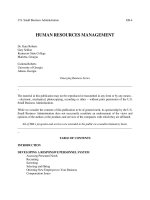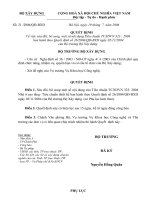Tài liệu E-Human Resource Management 21 pdf
Bạn đang xem bản rút gọn của tài liệu. Xem và tải ngay bản đầy đủ của tài liệu tại đây (742.43 KB, 9 trang )
166 Sherer & Shea
Copyright © 2005, Idea Group Inc. Copying or distributing in print or electronic forms without written
permission of Idea Group Inc. is prohibited.
of e-learning content, technology and services; as well as e-learning
conferences, seminars, workshops, and other e-learning events. The main
focus is on adult e-learning, i.e., e-learning in the workplace, in higher
education, and in continuing professional development.”
Syllabus Magazine ( “Syllabus’ mission is to in-
form educators on how technology can be used to support their teaching,
learning, and administrative activities. Each issue includes feature articles,
case studies, product reviews, and profiles of technology use at the
individual, departmental, and institutional level. Regular features cover
multimedia, distance learning, the Internet, quantitative tools, publishing,
and administrative technology. The Syllabus Web site supports and
expands upon the publication’s content covering the latest technology for
higher education.”
click2learn ( “Click2learn is the leading pro-
vider of enterprise software to help organizations improve workforce
productivity and business performance through the strategic application of
innovative learning software solutions and services.” Click2learn is an
example of a company that is “putting it all together” into a “one-stop-
shopping” business, providing tools for e-training development, delivery
(virtual classroom, collaboration, etc.), and evaluation (performance
management, learning management).
References
Alavi, M., & Leidner, D. (2001). Review. Knowledge management and
knowledge management systems: Conceptual foundations and research
issues. MIS Quarterly, 25(1), 107-136.
Aldelsberg, D., & Trolley, E. (1999). Running training like a business:
Delivering unmistakable value. San Francisco: Berrett-Koehler.
Allee, V. (2002). 12 principles of knowledge management: ASTD linking
people, learning and performance. Retrieved August 26, 2003, from
www.astd.org/CMS/templates/index.html?template_id=1&
articleid= 10595
Allen, M. (Ed.). (2002). The corporate university handbook. New York:
Amacom.
Keeping Up with the Corporate University 167
Copyright © 2005, Idea Group Inc. Copying or distributing in print or electronic forms without written
permission of Idea Group Inc. is prohibited.
American Productivity & Quality Center (APQC). (2000). The corporate
university: Measuring the impact of learning. Consortium Learning
Forum best-practice report. Houston, TX: American Productivity &
Quality Center.
American Society for Training and Development (ASTD). (2002). Retrieved
September 3, 2003, from www.astd.org/
Anderson, L. (2001). Tailor-made for life-long learning [Electronic version].
Financial Times (London), 1(March 26). Retrieved September 3,
2003, from web.lexis-nexis.com/universe
Argote, L., McEvily, B., & Reagans, R. (2003). Managing knowledge in
organizations: An integrative framework and review of emerging themes.
Management Science, 49(4), 571-582.
Baldwin, T., & Danielson, C. (2000). Building a learning strategy at the top:
Interviews with ten of America’s CLOs. Business Horizons, 43(6), 5-14.
Barley, K. (2002). Corporate university structures that reflect organizational
cultures. In M. Allen (Ed.), The corporate university handbook (pp.
43-65). New York: Amacom.
Barley, K. (2001). Finding golden nuggets: Making the most of corporate
university benchmarking. Workshop presentation at Corporate Univer-
sity Enterprise, Inc., Corporate University Site Tour, McLean, Virginia,
December 13-14.
Barth, S. (2002). Defining knowledge management. Retrieved August 16,
2003, from www.destinationcrm.com/print/default.asp?ArticleID=
1400
Bean, M. (2002). Methods that work in global enterprises. Chief Learning
Officer, 22(September).
Becker, B., Huselid, M., & Ulrich, D. (2001). The HR scorecard: Linking
people, strategy, and performance. Boston: Harvard Business School
Press.
Bellinger, G. (2002). Knowledge management—emerging perspectives.
Outsights. Retrieved August 16, 2003, from www.systems-thinking.org/
kmgmt/kmgmt.htm
Berry, J. (2000). Corporate training—the e-learning center—companies using
metrics to justify e-learning’s impact on strategic business goals.
Internetweek, 836(November 6), 61-64.
168 Sherer & Shea
Copyright © 2005, Idea Group Inc. Copying or distributing in print or electronic forms without written
permission of Idea Group Inc. is prohibited.
Carter, L., Giber, D., & Goldsmith, M. (Eds.) (2001). Best practices in
organizational development and change. San Francisco: Jossey-Bass/
Pfeiffer.
Dillich, S. (2000). Corporate universities. Computing Canada, 26(16), 25.
Fitz-enz, J. (2000). The ROI of human capital: Measuring the economic
value of employee performance. New York: Amacom.
Fulmer, R. (2002). Best practices in corporate universities. In M. Allen (Ed.),
Corporate university handbook (pp. 107-120). New York: Amacom.
Gabelhouse, G. (2002). Enterprise learning: A spending summary. Chief
Learning Officer, (September), 60-62.
Galvin, T. (2002). 2002 industry report. Training, 39(October), 24-52.
Global Learning Resources. (2001). The uses and misuses of the term
“corporate university”. Retrieved August 16, 2003, from glresources.com
Graunke, T. (2002). E-learning—the second wave. Chief Learning Officer,
13(September).
Hall, B. (2002). Six steps to developing a successful e-learning initiative:
Excerpts from the e-learning guidebook. In A. Rossett, The ASTD e-
learning handbook (pp. 234-250). New York: McGraw-Hill.
Jackson, S., & Schuler, R. (2003). Managing human resources through
strategic partnerships (8
th
ed.). Mason, OH: Thomson/Southwestern.
Jarvis, P. (2001). Universities and corporate universities: The higher
learning industry in global society. London: Kogan Page Limited.
Kaplan, S. (2002). KM the right way. CIO Magazine, (July 15). Retrieved
August 12, 2003, from cio.com/archive/071502/right_content.html
Kirkpatrick, D. (1998). Evaluating training programs: The four levels.
San Francisco: Berrett-Koehler.
Koprowski, G. (2000). Online learning: The competitive edge.
Informationweek, 801(August 28), 124-128.
Malhotra, Y. (2001). Knowledge management for the new world of business.
Retrieved August 26, 2003, from www.brint.com/km/whatis.htm
Mathis, R., & Jackson, J. (2003). Human resource management (10
th
ed.).
Mason OH: Thompson/Southwestern.
Meister, J. (1998). Corporate universities: Lessons in building a world-
class work force (2
nd
ed.). New York: McGraw-Hill Trade.
Keeping Up with the Corporate University 169
Copyright © 2005, Idea Group Inc. Copying or distributing in print or electronic forms without written
permission of Idea Group Inc. is prohibited.
National Alliance of Business. (2002). Corporate universities. Retrieved
September 3, 2003, from www.nab.com/corpuni.htm
Noe, R., Hollenbeck, J., Gerhart, B., & Wright, P. (2003). Human resource
management (4
th
ed.). New York: McGraw-Hill Irwin.
Parks, E. (2002). Dr. Parks’ top 10 2003 predictions for e-learning. Retrieved
September 3, 2003, from askintl.com/index.cfm/1,0,794,4389,693,441,
html
Prince, C., & Stewart, J. (2002). Corporate universities—an analytical frame-
work. The Journal of Management Development, 21, 794-811.
Prochaska, S. (2001). Is a corporate university in your organization’s future?
Society for Human Resource Management White Paper. Retrieved
August 16, 2003, from www.shrm.org
Rossett, A. (1999). First things fast: A handbook for performance analy-
sis. San Francisco: Jossey-Bass.
Rossett, A. (2002). The ASTD e-learning handbook. New York: McGraw-
Hill.
Santosus, M., & Surmacz, J. (2002). The ABCs of knowledge management.
CIO Magazine’s Knowledge Management Research Center. Retrieved
September 3, 2003, from www.cio.com/research/knowledge/edit/
kmabcs.html
Sauer, P. (2001). E-learning energizes as the next horizon in corporate training
with promises of cost savings. Chemical Market Reporter, (September
3), F8-F12.
Schank, R. (2002). Designing world-class e-learning. New York: McGraw-
Hill.
Schettler, J. (2003). Defense acquisition university: Weapons of mass instruc-
tion. Training, 40(2), 20-30.
Spitzer, D., & Conway, M. (2002). Link training to your bottom line. ASTD
Info-Line Report. Alexandria, VA: American Society for Training and
Development.
Sveiby, K. (2001). What is knowledge management? Retrieved September 3,
2003, from www.sveiby.com/library.html
Van Buren, M., & Erskine, W. (2002). Trends in employer-provided training
in the United States: ASTD State of the Industry Report 2002. Alexan-
dria, VA: American Society for Training and Development.
170 Sherer & Shea
Copyright © 2005, Idea Group Inc. Copying or distributing in print or electronic forms without written
permission of Idea Group Inc. is prohibited.
Vine, P., &, Palsule, S. (1999). Corporate universities: Back to school. The
British Journal of Administrative Management, (March/April), 18-
21.
Wexley, K., & Latham, G. (2002). Developing and training human re-
sources in organizations (3
rd
ed.). Upper Saddle River, NJ: Prentice-
Hall.









